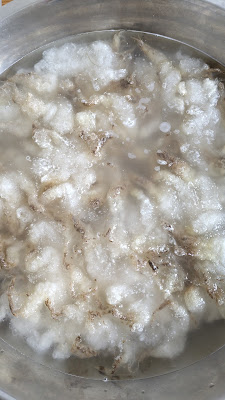Wow, after several years of silence, I suddenly feel the energy to post! This post is about the processing of the wool of Selma, one of our three Flevolander sheep, that came to us in spring 2021.
The fleece is Selmas first fleece, so shorn in 2022. The fleeces of the other two ladies (three sisters) are already processed and almost spun up. But Selmas has been lying there staring at me in a big blue plastic bag. To be honest, I was a little afraid that the moths had lived in the fleece, as the bag was open for a longer period, actually waiting to be processed but that never happened. Until now.
Now is between Christmas and New Years Eve, and I have taken a few days off from work. The Christmas stress is over, so now we have some really quiet days - it is like these days don't really exist, everything has come to a stand-still and there are no obligations at all. Even cooking dinner is easy because there is still so much food left over from Chistmas!

I started with rolling out the fleece on the floor. It actually looked quite good. It was yellowish, supposedly because it had been sitting in the bag, and the lanolin had stained it yellow. The sides were not very dirty, nor was the tail part included, a good job was done after the shearing and before packaging. Did I do that? I don't remember, but had expected a lot more dirt in it. In my memory the sheep were not easy to shear, there was a lot of mud and hay in the fleeces. Maybe I had already picked the fleece and removed those dirty parts. Nevertheless, I took away some of the outer parts of the fleece that I didn't want to process. Too dirty, too matted and I simply have enough wool to process without these difficult parts.
Then, I split it in three parts: (1) the back legs/belly/bottom (the trousers), (2) the front legs and belly and (3) the middle part, from the neck to the tail. Part 3 was further divided into the finest part, over the back and the shoulders (part 3.1), but not the neck. And the rest of that part (3.2).
Part 1 and 2 went back into the bag, for another day. Part 3 I have picked further, for double cuts and vegetable matter. As with the fleeces of her sisters, Selmas fleece had very dark and muddy tips. It was a lambs fleece after all, so the tips had been 'on the sheep' from before birth, in March 2021, and she was shorn late June 2022.
After that the parts got two cold baths with only water, to wash out the suint (is that sweat and pee?) and mud. Then, a hot bath of 20 minutes with wool wash (Ecover is what I use), and after that 2 somewhat cooler but still hottish/warm baths to wash out the soapy water. I used a spinner (is that the right word, people talk about the spin-cycle of their washing machines but this is a stand-alone machine, and in Dutch it is called a centrifuge). The spinner is of so much help! It spins out all the dirt water, or all the soapy water which would be left in the wool between the baths otherwise. Without the spinner, a double amount of rinse baths would be needed.
This is my woolwash set-up for the day. A smaller table is put in place, with a large stainless steel bowl for the washing. And the spinner to the right.
Finally, when all parts 3 were washed, rinsed and spin-cycled, I put them on a washing rack to dry. Phew! Now, only the leg-parts left to do.

















